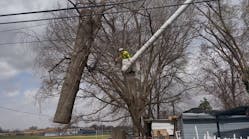Report: U.S. Utilities Are Adopting Digital Solutions as Climate Impacts Rise
Over half of U.S. utilities have updated vegetation management approaches because of climate change and 82% have or are looking to use digital tools to upgrade operations. This is in response to extreme weather events causing more severe storms and wildfires than ever before, more vegetation-caused outages, legal issues, and overall losses in the billions.
These are the findings of a survey of senior vegetation management executives in the utility sector conducted by AiDash, a leading provider of satellite and AI-powered operations, maintenance, and sustainable solutions. The results of the survey demonstrated that 11% of utilities have already made substantial changes and 41% had made some changes to vegetation management strategies. 48% are yet to make any updates but most do plan to adopt digital solutions by 2025 or later.
Utlities are also grappling with significant increases in contractor costs, decreasing or stagnant vegetation management budgets, and a skills shortage.
62% of survey responders reported increases of up to 15% in contractor service costs, with 11% witnessing a rise of more than 15%. In contrast, in 2023, over half (54%) of utility budgets allocated to vegetation management remained either stagnant or decreased, driven by a combination of unprecedented inflation, climate-related weather events, and reduced availability of resources. There is also a current manpower shortage of qualified arborists, which could potentially limit best practice efforts by delaying work and reprioritizing risk mitigation needs.
In the face of these challenges utilities are still making proactive and positive strides, currently prioritizing the delivery of reliable services to their customers, with the survey revealing that 64% use reliability as a key indicator to evaluate the company’s vegetation management strategy.
Furthermore, utilities are working on initiatives to address climate change, including biodiversity and net zero goals, and nearly 30% are taking an integrated vegetation management approach. Over 80% of vegetation management executives acknowledge the value of digital technology for vegetation management.
Using the findings from the survey, AiDash has produced three key steps for utilities to take to help successfully tackle vegetation management in 2024 despite the challenges they face:
1) Allocate budgets strategically: Vegetation management often represents the largest annual expense in utility budgets. Embracing technology and allocating resources more intelligently, such as deploying the right crews to where they are needed and optimizing equipment usage, can enable more dynamic vegetation management approaches.
2) Embrace technology for contractor auditing: Traditionally, vegetation management has heavily relied on manual labor, making it a costly and labor-intensive process. As the majority of utilities still rely on manual auditing of contractor’s work, but there is a significant opportunity to automate this process, which would lead to time and cost savings.
3) Set up processes to enable nimble responses to climate change: Climate change has undoubtedly begun to impact businesses across various sectors, including utilities, who now face increasingly severe climate-related challenges. By adopting faster, more dynamic, intelligent vegetation management before, during, and after storms, utilities can better equip themselves to address the various aspects of climate change.
Digital technology providers can also take steps to improve the level of support they provide utilities. The survey demonstrated the need for enhanced digital tools and software solutions able to monitor tree health in real time with nearly half (41%) identifying this as a key gap.
“Utilities need modern digital tools to adapt to the new challenges posed by climate change while continuing to provide essential services to their customers," said CEO of AiDash Abhishek Vinod Singh. "They have the opportunity to use digital tools to optimize vegetation management and improve safety for their staff and contractors.”


